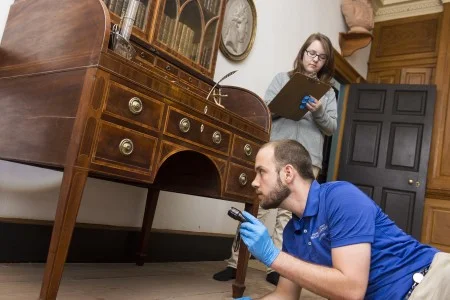Before Mount Vernon opens its doors to greet its first visitors, the estate’s staff works swiftly and efficiently behind the scenes to prepare for its guests—no small feat for an extensive, 400-acre property that’s open 365 days a year.
Many of these important tasks take place early in the morning.
As Mount Vernon "wakes up."
6 a.m. — Collections and Preservation
The rooms inside the Mansion, perused and traversed by one million visitors each year, require constant upkeep. The daily tasks of cleaning fall to Mount Vernon’s Collections and Preservation teams.
Like a well-oiled machine, they work carefully and efficiently, sticking to a strict routine in order to complete the job before the Mansion opens. The method of cleaning varies from item to item; Collections team members vacuum textiles and carpets, dust surfaces, and clean light fixtures, paintings, and smaller objects by hand. As they work, the staff completes a condition report for each object, recording any cracking, evidence of pests, or fluctuations in temperature and humidity that could impact the collection. The Preservation team maintains the architectural elements.
Although the staff works almost exclusively behind the scenes, the product of their early morning labor is enjoyed by every guest who walks through the Mansion.
“Objects are a physical connection to history, and we’re the caretakers,” says one Mount Vernon assistant collections manager. “To be able to work in the space where George Washington and his family lived is so special.”
Cleaning Mount Vernon
Before the first guests arrive, Mount Vernon's dedicated staff works behind-the-scenes to prepare the estate for visitors.
7 a.m. — Livestock
Mount Vernon’s livestock staff works 365 days a year to take care of the estate’s horses, chickens, pigs, cattle, sheep, and oxen.
“Animals were very important to George Washington,” said Livestock Supervisor Lisa Pregent. “Washington probably had the breed of cattle we do, and the sheep and hogs represent the colonial breeds he had.”
The crew begins each day by putting on their head-to-toe work gear. During their first hour, the team splits into two groups to do rounds, loading up their vehicles with food for the animals in the historic area and the livestock barn. They finish their morning tasks by cleaning out the stalls, exercising the horses, and trimming the hooves of sheep and horses.
The arrival of spring brings an exciting new task for the livestock staff: the birth of lambs. “Lambing is the most exhausting task, but is by far the most rewarding,” Lisa remarks. Beginning in April, some staff members dress in period costumes and go to the estate for interpretation, teaching guests about Washington’s animals.
“The animals help bring the estate to life,” Lisa explained, “Many [guests] have never seen a horse or a pig before, and we educate the general public about the importance of livestock in colonial times and tie it in to today.”
Feeding the Animals at Mount Vernon
Enjoy breakfast with our livestock team and the sheep, oxen, pigs, and other rare heritage breed animals on George Washington's farm.
7:30 a.m. — Horticulture
Dean Norton began working at Mount Vernon on the estate’s grounds crew as a paper picker 47 years ago. He fell in love with the work—being outside and working with his hands—and decided to pursue a degree in horticulture. After graduating from Clemson University, he became the estate’s boxwood gardener and in 1980 was promoted to horticulturist, the position he still holds. Although Dean’s tasks are now primarily administrative, he has been sure to retain one manual task for himself: making the boxwood wreaths displayed at Washington’s Tomb. First, he places moist sphagnum moss in a wire wreath frame and wraps it with floral wrap. Then he sticks about 80 boxwood cuttings into the frame to complete the wreath.
Boxwoods are special to Dean, just as they are to Mount Vernon. Washington’s gardeners planted English boxwood in the upper garden in 1798, keeping the plants neatly trimmed along the garden’s edge or in ornamental shapes—a tradition the horticulture staff has maintained since the garden’s 2011 restoration. Although the English boxwood’s susceptibility to disease prevents it from growing in the gardens today, the upper garden features boxwood edging from a disease-resistant cultivar.
Creating the Wreath for Washington's Tomb
Come behind the scenes at Mount Vernon, and learn about two different legacies: The long standing tradition of laying an English boxwood wreath at General Washington's tomb, and the legendary career Dean Norton, our director of horticulture.
8:45 a.m. — Interpretation
The ritual of opening Washington’s Tomb takes roughly 10 minutes from start to finish. First the designee unlocks the black gate and opens the doors to the Tomb. Then he or she retrieves the flags that flank the entrance to the Tomb and puts them in their stands. The placement of the U.S. flag on the left side of the opening always precedes the placement of Washington’s commander-in-chief flag on the right. Next, the stanchions that direct the flow of visitors through the Tomb are erected. And, finally, the boxwood wreath and its stand are placed between the sarcophagi of George and Martha Washington.
This task rotates among the interpretive staff.
Opening George Washington's Tomb
Take an inside look at the everyday process and the traditions involved in preparing the tomb of America's first President for visitors.
9 a.m. — The Texas Gate opens
Another day begins at Mount Vernon, which hosts roughly 1 million visitors per year.
Plan Your Visit Today






